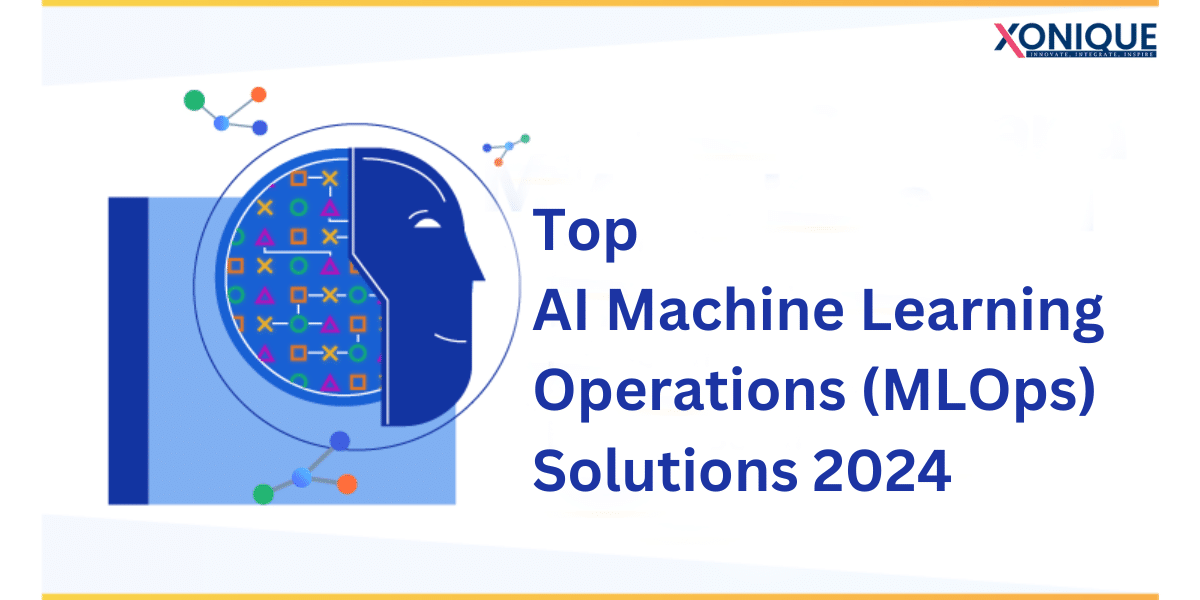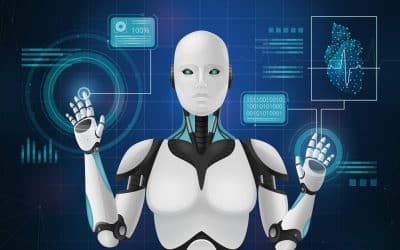Machine learning (ML) is the process of making predictions using data. This is in contrast to traditional programming, in which the programmers provide the computer with a set of guidelines for computers to follow. The software can categorize, segment, or label the data. It can also be used for predictions, forecasting, optimization, and personalization, to name a few.
This is where MLOps Services is introduced. It represents the unification of operations and machine learning. This refers to the methods and techniques employed to create better communication within the business. MLOps deployments automatize the machine learning process to improve deployment effectiveness and continuous integration.
Machine learning models are becoming more popular and integrated into software and applications; the MLOps procedure has become increasingly crucial. This type of AI-powered machine learning tool has come into existence to help ML teams test deployment, deploy, and retrain ML models to eliminate errors or defects.
The MLOps solutions discussed in this article assist businesses in developing and maintaining machine learning models and workflows. They also allow rapid deployment, implement policies that govern ML models, and facilitate team collaboration. This post will dive deep into the most effective MLOps solutions and examine their main capabilities and benefits.
What Are MLOps?
MLOps is a shorthand for Machine Learning Operations. This is a new form of administration for systems that are required today, and machine learning is taking over. MLOps is a tool for monitoring, optimizing, modeling, and automating the machine learning process.
Machine learning is based on the knowledge gained from data to build models, which can be used to generate predictions or make recommendations. In the face of an exponentially increasing quantity of mobile devices, gadgets equipped with various capabilities, and multiple applications in our daily lives, these sources allow developers to build efficient and reliable apps using less work. The resources mentioned above are connected on a single platform called MLOps.
MLOps is the primary function and critical component of machine learning engineering. It focuses on streamlining the process of getting machine learning models into production while monitoring their performance and maintaining them over time. MLOps is a team-based task usually involving researchers, data analysts, DevOps experts, and IT professionals.
How Does MLOps Work?
To comprehend how MLOps operates, it is essential to understand the idea of testing and creating models for ML in different systems. MLOps enhances automation and increases production quality by ensuring it meets regulatory and business requirements. MLOps ensures ML models function as intended before production through separate development and testing procedures. This process lets data scientists and MLOps Engineer check and verify the models to ensure their accuracy and performance.
MLOps encompasses the machine learning process, from creation to deploying models and checking against measures. The system combines the concepts of continuous delivery and automation of data from DevOps along with the particular demands of ML models. With the help of MLOps’ top practices, companies can streamline their ML projects and achieve effective and stable performance.
Why Do We Need MLOps Deployment?
MLOps is a methodological approach that applies the principles of DevOps to developing machine learning-related projects. By incorporating the most effective software development methods with operation, MLOps enables teams to create, deploy, and maintain ML systems faster and more efficiently.
The approach simplifies the complete ML cycle, from data preparation and modeling training to monitoring and deployment, ensuring high robustness, scalability, and the ability to maintain machine learning platforms. MLOps’ collaborative and automated platform facilitates organizations’ ability to respond swiftly and confidently to market changes, iterate models rapidly, and offer quality machine learning (ML) solutions without risk or doubt.
We’ll now look into some of the advantages and the reasons why MLOps is vital for businesses:
Automation And Efficiency
MLOps simplifies machine learning development and deployment processes by automating repetitive tasks and decreasing manual intervention needs. This allows for faster growth of models and deployment. It also saves both time and money.
Scalability
Through MLOps, businesses can effortlessly increase the size of their machine-learning workflows to deal with more significant amounts of data and more complicated models. Scalability is crucial when businesses expand and require more information.
Model Monitoring And Management
MLOps offers tools and procedures to monitor the effectiveness of machine learning models. It can help identify the presence of anomalies and issues, making it possible to make timely updates to models and enhancements.
Collaboration And Version Control
MLOps allows collaboration between researchers, developers, and operations personnel by allowing version control and tracking the developments in machine learning models. This helps improve communications and coordination during the entire development process.
Compliance And Risk Mitigation
MLOps firmly believes in security and conformity to help organizations reduce the risk of dealing with sensitive information and ensure that models conform to the industry’s regulations and standards.
Continuous Improvement
MLOps facilitates continuous integration and continual deployment (CI/CD) for machine learning models. It allows businesses to quickly explore different strategies and continually improve the model’s performance.
Constant Value And Less Risk
MLOps helps reduce the risk associated with data science, machine learning, and AI aspects and assists organizations in building long-term value.
Quick Innovation And Quick Deployment
MLOps enhances collaboration and automatization, facilitating faster transformation and creating the w ML solutions. Additionally, it improves the ongoing implementation, deployment, and delivery process for ML solutions.
Efficient Lifecycle Management
MLOps enhances the effectiveness of teams across the globe and helps you efficiently finish creating your machine-learning project, from conception to implementation.
Key Features Of MLOps Tools
Below are some key attributes that help make MLOps devices indispensable to researchers and machine learning researchers.
End-To-End Workflow Management
An extensive MLOps tool will offer a complete workflow management tool that streamlines complicated processes in creating, training, and deploying ML models. It also supports features engineering, data processing, hyperparameter tuning models, and many more. An adequately designed workflow management tool allows teams to work effectively by automating routine tasks and providing transparency in every procedure phase.
Model Versioning And Experiment Tracking
One of the most critical aspects of MLOps Solutions is its capacity to keep track of experiments and manage the different versions of models that are trained effectively. When proper version control is implemented, groups can quickly compare various iterations of the model or go back to prior versions in the event of a need.
Scalable Infrastructure Management
A scalable infrastructure is vital when handling huge-scale projects in machine learning because it allows optimal resource usage during the inference and training phases. Most MLOps instruments enable seamless integration with cloud-based machine learning platforms or local environments utilizing container orchestration tools like Kubernetes.
Training Distributed
With the increase of models and data in number, distributed training will be required to decrease the time needed for modeling training. MLOps applications should incorporate parallelization methods, such as data or model parallelism, to efficiently use multiple GPUs and compute nodes.
Automated Resource Allocation And Schedule
Practical MLOps tools need to include automated allocation of resources and scheduling tools that assist in maximizing the use of infrastructure by continuously adapting resources to the workload needs. This allows for optimal use of resources and reduces the costs of inactive hardware.
Model Monitoring And Continuous Improvement
To maintain quality, ML models are a continuous evaluation and enhancement process throughout their lifespan. A reliable MLOps system should include options like monitoring performance metrics as well as drift detection and abnormality alerts to ensure that the models used are maintaining the desired levels of accuracy over time.
Integration Into Existing Tools And Frameworks
To maximize efficiency and reduce interruption to workflows already in place, optimize efficiency and minimize disruption. The ideal MLOps platform must easily integrate with top machine-learning frameworks like TensorFlow and PyTorch and other software commonly utilized by researchers (such as Jupyter notebooks). Additionally, it must allow custom integrations through SDKs or APIs, allowing for the most excellent adaptability to different contexts.
Top MLOps Tools
Choosing the appropriate MLOps Tools is essential for machine learning and can significantly affect your team’s efficiency and overall success. Below are some of the most effective MLOps instruments available right now.
Amazon SageMaker
Amazon SageMaker is a fully controlled service from AWS that provides data scientists with a full-service platform to build, train, and deploy Mac-deploying models. The service has built-in algorithms to handle typical ML tasks and the ability to create custom algorithms with well-known frameworks such as TensorFlow and PyTorch. Furthermore, SageMaker enables easy scaling of model training across distributed systems while offering the ability to optimize costs, such as Managed Spot Training.
Comet
Comet is a machine-learning platform for development teams that allows them to control, monitor, streamline, and improve their AI models across the complete cycle of a machine-learning model’s life. Comet is backed by many users, as well as many Fortune 100 companies, including Shopify and Uber. As of now, Comet has raised more than 50 million dollars in capital investment.
Comet aids AI teams in building solid AI models. It allows teams to monitor, evaluate the results, implement and improve the models they build quickly and easily using data and insights for better efficiency and transparency. Its software is easy to integrate with the ML platform and allows you to begin tracking metrics and code swiftly. Teams can create custom data visualizations and manage models, schedule deployments, and track models after they’re running.
MLflow
A project that is open source and developed by Databricks, MLflow aims to simplify different aspects of machine-learning lifecycle management. This includes the tracking of experiments and replication enforcement in other contexts, accomplished by packing code in containers, referred to as “projects,” and sharing trained models between teams or groups. Also transferring models to production. Modular design makes it possible to integrate with current ML tools easily.
Iterative
Iterative facilitates modeling of models using machine learning in teams using various developer tools. They aim to decrease the work of managing large ML and infrastructure datasets and improve lifecycle management. Thousands of ML teams of every size, including start-ups and Fortune 500, use iterative.
Through iteration, teams can improve collaboration, automate workflows, and control data throughout the lifecycle of ML. Teams can develop models and automate training using integrated collaboration tools and customized dashboards that help increase efficiency. Iterative helps teams monitor and keep track of the development of their projects and experimentation to ensure that the regulatory and compliance requirements are fulfilled.
Azure Machine Learning
Azure Machine Learning is Microsoft’s cloud-based solution for ML design and deployment. It is aimed at simplifying complicated workflows. It works with open-source frameworks, such as TensorFlow and PyTorch, seamlessly integrating with Azure services like Azure Functions and Kubernetes Service (AKS). Additionally, it comes with sophisticated capabilities like automatic Hyperparameter Tuning (HyperDrive) to improve the performance of models efficiently.
TensorFlow Extended (TFX)
TensorFlow Extended (TFX) is an all-in-one platform designed for TensorFlow users. It offers tools that span all aspects of machine learning, including data input and validation through model development serving, monitoring, and even monitoring. The flexibility of TFX allows seamless integration into workflows. It will enable reproducibility across various settings by supporting containers using Docker and Kubernetes.
Kubeflow
Based on Kubernetes, Kubeflow is an open-source initiative to facilitate the implementation of machine-learning workflows on-premises or in the cloud. Utilizing Kubernetes’ native capabilities, including scalability and failure tolerance, Kubeflow is a platform capable of handling complicated ML tasks efficiently. It is compatible with the most popular ML frameworks, such as TensorFlow and PyTorch, and works with various MLOps tools, such as MLflow and Seldon Core.
What Are The Best Methods To Use For MlOps?
Best practices in MLOps are determined in the context of where MLOps principles are implemented.
Exploratory Data Analysis (EDA)
Explore the possibilities of sharing, preparing, and storing data for machine learning by preparing reproducible, editable, and shareable data sets, tables, and visualizations.
Data Prep And Feature Engineering
Iteratively transform, aggregate, and eliminate duplicate data to produce enhanced capabilities. In addition, you can make the feature visible and accessible to data teams using the feature store.
Tuning And Training Models
Utilize widely-used open-source libraries like scikit-learn or hyperopt to improve and train model performance. For a more straightforward alternative, utilize automated machine-learning tools like AutoML to automate tests and produce executable, reviewable code.
Review Of Models And The Governance
Monitor model lineage and model variations and track the transitions of models and artifacts throughout their entire lifecycle. Explore, share, and work together across ML models by using an open-source MLOps platform like MLflow.
Model Inference And Service
Monitor the frequency of refreshes to model time, inference requests, and other similar production-specifics for testing and quality assurance. Utilize CI/CD tools like repos or orchestrators (borrowing concepts from DevOps) to streamline the pre-production process.
Monitoring And The Deployment Of Models
Automate the creation of clusters and permissions for productionizing model registrations. Enable REST API model endpoints.
Automated Model Retraining
Automate alerts and create automation to corrective actions if the model drifts due to differences in inference and training information.
Critical Considerations For Successful MLOps Implementation
We must think about critical aspects to ensure the successful deployment of MLOps. Including standardization of methods, managing data sets to deploy models, ensuring conformity, and closing the gaps between data scientists and operational teams.
- Using consistent tools and frameworks throughout the MLOps workflow will help streamline processes and enhance collaboration.
- The proper data management procedures, including data quality control and version control, are essential for ensuring accurate and safe model training.
- Effective deployment strategies will ensure that ML models seamlessly integrate into production systems, benefiting businesses.
- Respecting ethical and regulatory standards is critical to safeguarding sensitive customer information and earning trust.
- Communication and effective collaboration between teams ensure the seamless transfer of models created by ML to be used in maintenance, deployment, and even monitoring.
- Considering these critical factors is crucial to effectively implementing MLOps, which will allow companies to harness the potential of machine learning for growth and prosperity.
Future Trends In MLOps
The next phase of MLOps looks promising, with advances in automated operations, AI-driven processes, and increased cooperation between operations and data science teams. These advancements will impact how businesses implement and manage ML models. This will result in better and more effective procedures.
These are the major trends are likely to be seen shortly for MLOps:
- As technology advances, we can expect greater automation of solutions for MLOps. These will simplify processes, reduce the manual burden, and help organizations scale the size of their ML operations.
- Integrating AI into MLOps can improve the process of making decisions and improve the allocation of resources. AI algorithms examine data and give information to boost modeling performance and operational efficiency.
- Collaboration between data scientists and operations teams will be essential shortly. These teams can leverage each other’s skills to create and implement algorithms that will meet the business’s goals.
- When the need for MLOPs rises and the demand for MLOps increases, we will witness the development of new instruments and platforms. They will provide extensive capabilities for managing ML projects from all levels, starting with data preparation and moving to the deployment of models and tracking.
- With these advances shortly and the present, MLOps offers excellent opportunities for those who want to optimize and automate the scale of their ML processes. If they embrace these developments and invest in the MLOps tools, businesses can remain at the forefront and realize the total value of their machine-learning initiatives.
Conclusion
In the highly competitive market, businesses are now looking at Artificial Intelligence and Machine and Deep Learning to convert large amounts of data into practical data. This allows them to communicate more effectively with their audiences, improve the quality of their decision-making process, and streamline the supply chain and production procedures, to name a few of the numerous use cases available.
The MLOps ecosystem offers a wide assortment of software and platforms designed to enable organizations and people to efficiently manage an element or all of the machine learning process. This dynamic ecosystem comprises commercial and open-source products, which address different stages in the ML workflow. The field was quickly changing, offering practitioners various options for efficiently implementing machine learning. To stay in the forefront and realize the full potential of ML However, businesses should strategically adopt MLOps.











